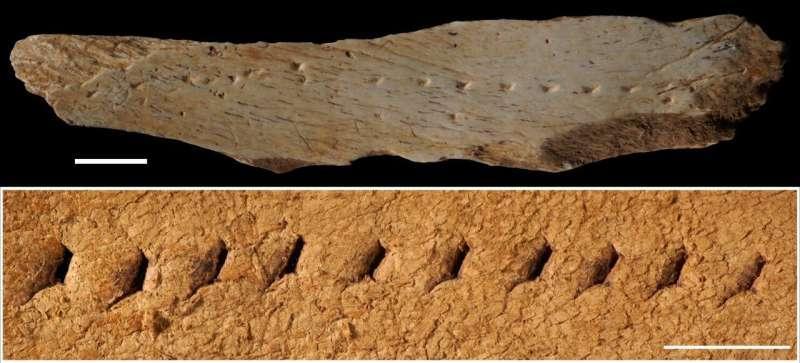Bob Yirka , Phys.org
Source - https://phys.org/news/2023-04-perforations-ancient-bone-fragment-base.html
 A 39,600-year-old leather punch board from Canyars, Gavà, Spain. Credit: Francesco d'Errico and Luc Doyon
A 39,600-year-old leather punch board from Canyars, Gavà, Spain. Credit: Francesco d'Errico and Luc Doyon
A team of archaeologists and anthropologists from Université de Bordeaux, Institut Polytechnique de Bordeaux and Universitat de Barcelona, has found evidence of a tool used to make leather clothing dating back to the Upper Paleolithic. In their study, reported in the journal Science Advances, the group analyzed a bone fragment with marks that they believe reveal new details about human history on the Iberian Peninsula.
The bone fragment was found at a dig site called Terrasses de la Riera dels Canyars, located close to Barcelona, Spain. Because it had no collagen, the fragment could not be dated directly. Instead, the team inferred its age using the age of material around it—they believe it was from approximately 39,600 years ago, from the middle of the Upper Paleolithic.
At that time, the researchers note, Europe and the Iberian Peninsula were cold—more like modern Siberia than today's warm Mediterranean climate. That would have necessitated warm clothes made using animal hides. To make them fit, they further reasoned, would require stitching parts together. However, needles with eyes had not been invented yet. Thus, the best way to pass a thread through a hide was to punch a hole in it first, using an awl-like tool called a burin, which requires something underneath to serve as a base. They believe the fragment they found is just such a base. The marks on it, they suggest, are the results of a burin striking it after passing through a piece of leather.
The team came to this conclusion by closely studying the marks on the bone fragment. They were lined up in a way that proved they were not made by animal bites, or human bites, for that matter. Next, they fashioned several variations of their own burins out of stone and placed a large animal bone underneath a piece of leather to use as a base and pounded holes through it, finding that the same types of marks appeared.
The research team notes that by using this technique, early humans could also have made other things from animal skins, such as shoes or bags.
Luc Doyon et al, A 39,600-year-old leather punch board from Canyars, Gavà, Spain, Science Advances (2023). DOI: 10.1126/sciadv.adg0834